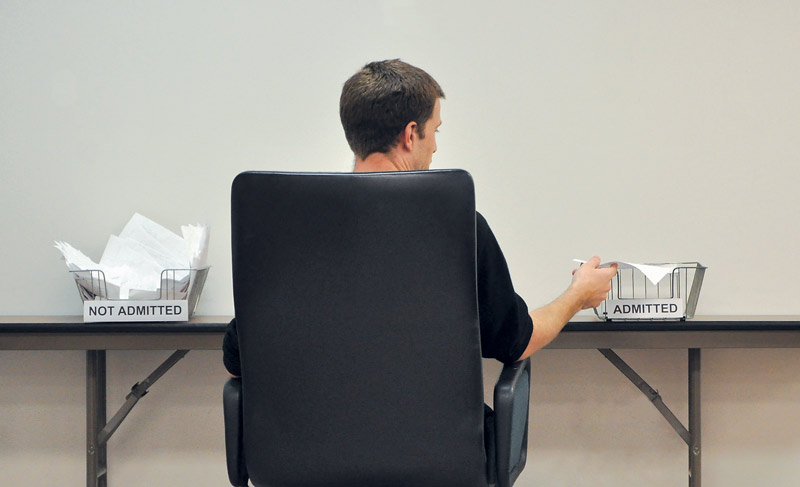
Applications submitted to California State University (CSU) campuses this year have almost doubled since last year’s application period, in just the first month.
CSU Mentor, the CSU application submission Web site, recorded a total of 187,329 submissions between Oct. 1 and Oct. 28, compared to 124,684 during that same period last year.
The largest increase of applications, according to the CSU Web site, came from community college students, with more than 41,000 applying to transfer to a CSU, nearly three times higher than last year’s numbers.
Suzy Babikan, associate director of Admissions and Records, said that since Oct. 1, CSUN received 10,684 applications for the Fall 2010 semester.
Anabel Diaz, a 28-year-old psychology major and a transfer student herself, works in the transfer center at the Los Angeles Mission College, where she assists transfer students in filling out their applications.
Diaz said she assists about 20 to 25 students at the transfer center a day — sometimes up to 35 students.
She said that through the Transfer Admission Guarantee (TAG) agreement, many students are guaranteed admission into universities, as long as they complete the necessary requirements needed to transfer and maintain a high GPA.
Diaz said that although many students rely on the TAG agreement, it does not always guarantee admission.
“If they don’t meet their required courses and they haven’t completed their lower division requirements, (they won’t get in). It also depends on how competitive their major is,” Diaz said.
Babikan said that because the application period has been extended, the number of applicants has gone up.
“The number of applications received the first day was up. Because of all of the media coverage, and the fact that the CSU did not accept applications for spring, students are applying early,” Babikan said.
But with mandatory furloughs, the admissions office has not been able to process the applications as quickly as in the past.
“The response time will be longer. However, no decision can be made until the student completes their file. Once a student submits all of their transcripts and test scores, we can determine eligibility for admissions,” she said.
Dr. Harry Hellenbrand, CSUN provost and vice president of academic affairs, said the school is capped in enrollment for next year.
“We’ve been ordered to decrease enrollment by 11 percent … and we’re going to be operating on a significantly lower budget for next year. It’s going to be harder for everyone,” he said.
Hellenbrand said cuts will be made to elective offerings, and the school is doing what they can to not make cuts to any programs. Although, it is possible that we will have fewer classes than before, he said.
With the lack of state funding, CSUs will have a difficult time accommodating all of the applicants.
Jim Blackburn, CSU director of Enrollment Management Services, said during a podcast interview that the budget cuts would pose a challenge for incoming students in the next two years.
“We will need over the next two years to enroll 40,000 fewer students in order to guarantee the same quality that Californians have grown to expect from the CSU,” Blackburn said.
Diaz said it’s easier for a student to get into a University of California (UC) school than a state school at this point.
“They have a better chance of getting into a UC than a CSU. It’s easier for transfer students as long as they do their requirements and community service,” she said.
Blackburn also discussed the possibility of raising admission standards. He said that impacted campuses are permitted to raise their admission standards.
“On the 12 campuses that are, in the lingo, ‘impacted,’ those campuses will be permitted to use higher admission standards in selecting their class – so (they can) be completely driven by how many people apply and how well qualified they are,” Blackburn said.
“So, it’s entirely possible that not everybody who meets the state minimum will be admitted to those 12 campuses,” he said.
Hellenbrand said that will not be the case for CSUN. He said the school will not raise admission standards, and they will remain the same as they have been in the past.
The main idea that the CSUs have been trying to get across to incoming students is to have a secondary option.
“They need to have a backup plan; a campus that would perhaps be accessible to them if their first choice has not been able to admit them. Quite often a good second choice is the local campus, the campus nearest a student’s home where often there is additional priority for local residents,” Blackburn said.
Hellenbrand said the reason why so many students are trying to get into a state school is because many were not able to attend in the spring, since no new students are being admitted this year.
“Also, a lot of people are out of work,” he said, “and that’s when people go back to school.”
Diaz said that with the state of economy, many students see a higher education as a way to secure a steady-paying job.
“Money always influences people to do something … it influenced me to finish school. A lot of people are overworked; people want to go back to school so they can get a better job,” she said.




